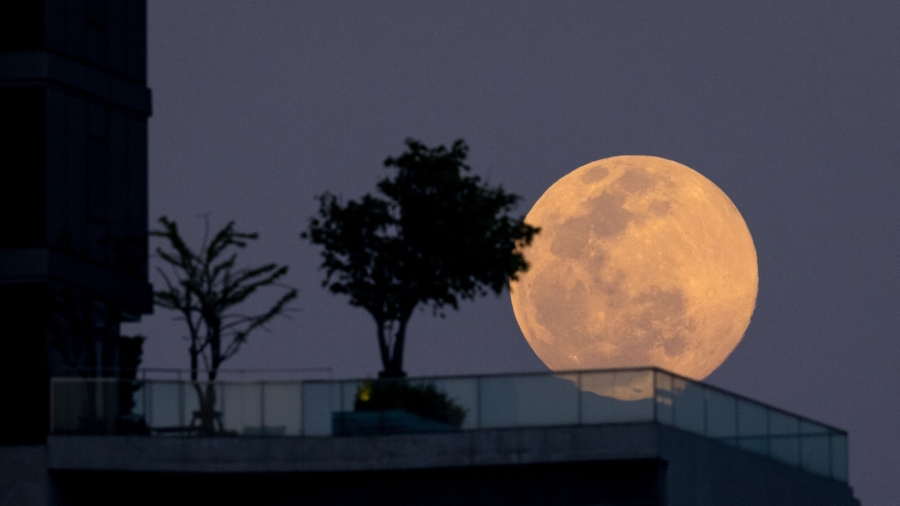The first full moon of the year is known as the wolf moon, and appeared in the evening of Monday, Jan. 17.
The moon was named after wolves that were thought to howl more frequently this time of year, according to the Old Farmer’s Almanac.
Moon gazers around the world caught a glimpse of the full moon.


More Than a Wolf Moon
There is a cornucopia of names for the January full moon besides the wolf moon, including the Old Moon and Ice Moon.
Assiniboine people who live in the Northern Great Plains in the United States call this the center moon because it is around the middle of winter, according to the Old Farmer’s Almanac.
Algonquin people located northeast of the Great Lakes, also in the United States, call it “squochee kesos,” which means, “sun has not strength to thaw.” The Cheyenne people of the Great Plains call it “moon of the strong cold.”
Full Moons and Supermoons
There are 12 full moons in 2022, and two of them qualify as supermoons.
Definitions of a supermoon can vary, but the term generally denotes a full moon that is brighter and closer to Earth than normal, and thus appears larger in the night sky.
Some astronomers say that the phenomenon occurs when the moon is within 90 percent of perigee—which is its closest approach to Earth in orbit. By that definition, the full moon for June as well as the one in July will be considered supermoon events.
Here is the list of the remaining full moons for 2022, according to the Farmers’ Almanac:
• Feb. 16: Snow moon
• March 18: Worm moon
• April 16: Pink moon
• May 16: Flower moon
• June 14: Strawberry moon
• July 13: Buck moon
• Aug. 11: Sturgeon moon
• Sept. 10: Harvest moon
• Oct. 9: Hunter’s moon
• Nov. 8: Beaver moon
• Dec. 7: Cold moon
While these are the popularized names associated with the monthly full moon, each one carries varied significance across Native American tribes.
Lunar and Solar Eclipses
There will be two total lunar eclipses and two partial solar eclipses in 2022, according to The Old Farmer’s Almanac.
Partial solar eclipses occur when the moon passes in front of the sun, but only blocks some of its light. Be sure to wear proper eclipse glasses to safely view solar eclipses, as the sun’s light can be damaging to the eye.
A partial solar eclipse on April 30 can be seen by those in southern South America, the southeastern Pacific Ocean, and the Antarctic peninsula. Another one on Oct. 25 will be visible to those in Greenland, Iceland, Europe, northeastern Africa, the Middle East, western Asia, India, and western China. Neither of the partial solar eclipses will be visible from North America.
A lunar eclipse can occur only during a full moon when the sun, Earth, and moon align, and the moon passes into Earth’s shadow. Earth casts two shadows on the moon during the eclipse. The penumbra is the partial outer shadow, and the umbra is the full, dark shadow.
When the full moon moves into Earth’s shadow, it darkens, but it won’t disappear. Sunlight passing through Earth’s atmosphere lights the moon in a dramatic fashion, turning it red—which is why this is often referred to as a “blood moon.”
Depending on the weather conditions in your area, it may be rusty, brick-colored or blood red.
This happens because blue light undergoes stronger atmospheric scattering, so red light will be the most dominant color highlighted as sunlight passes through our atmosphere, and casts it on the moon.
A total lunar eclipse will be visible to those in Europe, Africa, South America, and North America (excepting northwestern regions) between 9:31 p.m. ET on May 15 and 2:52 a.m. ET on May 16.
Another total lunar eclipse will also be on display for those in Asia, Australia, the Pacific, South America, and North America on Nov. 8 between 3:01 a.m. ET and 8:58 a.m. ET—but the moon will be setting for those in eastern regions of North America.
Meteor Showers
The new year kicked off with the Quadrantid meteor shower, which peaked during the first week of January.
The next meteor shower, the Lyrid meteor shower, doesn’t peak until April.
Here are the other showers to watch for in 2022:
• Lyrids: April 21–22
• Eta Aquariids: May 4–5
• Southern delta Aquariids: July 29–30
• Alpha Capricornids: July 30–31
• Perseids: Aug. 11–12
• Orionids: Oct. 20–21
• Southern Taurids: Nov. 4–5
• Northern Taurids: Nov. 11–12
• Leonids: Nov. 17–18
• Geminids: Dec. 13–14
• Ursids: Dec. 21–22
If you live in an urban area, you may want to drive to a place that isn’t littered with city lights that will obstruct your view. If you’re able to find an area unaffected by light pollution, meteors could be visible every couple of minutes from late evening until dawn.
Find an open area with a wide view of the sky. Make sure you have a chair or blanket so you can look straight up. And give your eyes about 20 to 30 minutes to adjust to the darkness—without looking at your phone—so the meteors will be easier to spot.
The CNN Wire contributed to this report.


